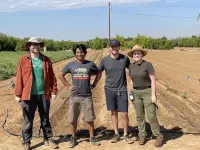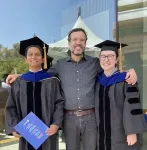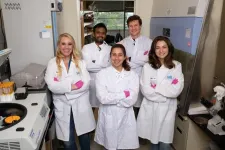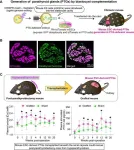(Press-News.org) RIVERSIDE, Calif. -- Plants form alliances with microbes in the soil in which they grow. Legumes, for example, benefit from a symbiotic relationship with microbes that inhabit nodules in their roots and “fix” nitrogen in the atmosphere to make it available to promote the legumes’ growth. But are microbes always beneficial to plants? Or does competition between strains for plant access degrade the service the bacteria ultimately provide?
A team led by scientists at the University of California, Riverside, set up experiments to answer these questions and better understand the competition process. The researchers used a native California plant with nodules, Acmispon strigosus, and a set of eight compatible nitrogen-fixing bacterial strains. They infected some plants with each of the eight strains to directly measure their ability to infect the plants and provide benefits. They then infected other plants with pairs of bacterial strains to assess the competitive ability of each strain and the effect on plant performance.
The researchers found that competition between strains of beneficial bacteria in the soil degrades the service that the bacteria provide to their hosts.
“More specifically, we found interstrain competition that occurs in the soil before the bacteria infect the plant causes fewer of the bacteria to colonize the plant, resulting in the plant gaining smaller benefits in the end,” said Joel Sachs, a professor of evolution, ecology, and organismal biology, who led the research team. “To understand symbiosis, we often use sterile conditions where one strain of bacteria is ‘inoculated’ or introduced into an otherwise sterile host. Our experiments show that making that system slightly more complex — simply by using two bacterial strains at a time — fundamentally shifts the balance of benefits that the hosts receive, reshaping our understanding of how symbiosis works.”
Study results appear in the journal Current Biology.
Sachs explained that a core challenge in agriculture is leveraging the services that microbes can provide to crops by promoting growth in a sustainable way, without the environmental costs of chemical fertilizers. His lab studies rhizobia — bacteria that promote plant growth. Rhizobial competition is a longstanding problem for sustainable agriculture. Rhizobia form root nodules on legumes, within which the bacteria fix nitrogen for the plant in exchange for carbon from photosynthesis. Growers have long sought to leverage rhizobia to sustainably fertilize staple legume crops such as soybean, peanuts, peas, and green beans.
“One might think using rhizobia as inoculants should allow growers to minimize the use of chemical nitrogen, which is environmentally damaging,” said Sachs, who chairs the Department of Evolution, Ecology, and Organismal Biology. “But such rhizobial inoculation is rarely successful. When growers inoculate their crops with high-quality rhizobia — strains that fix a lot of nitrogen — these ‘elite’ strains get outcompeted by indigenous rhizobia that are already in the soil and provide little or no benefit to hosts.”
In their experiments, Sachs and his colleagues used bacterial strains whose genomes they had already sequenced. They also characterized the strains, which ranged from highly beneficial to ineffective at nitrogen fixation, to know exactly how beneficial they were to the target plant species. The researchers sequenced the contents of more than 1,100 nodules, each of which was from a plant that was inoculated with one of 28 different strain combinations.
Next, the researchers developed mathematical models to predict how much benefit co-inoculated plants would gain based on expectations from plants that were “clonally infected” (infected with one strain). This allowed the researchers to calculate the growth deficit that was specifically caused by interstrain competition.
“Our models showed that co-inoculated plants got much lower benefits from symbiosis than what could be expected from the clonal infections,” said Arafat Rahman, a former graduate student in Sachs’ lab and the first author of the research paper. “While beneficial bacteria work well in the lab, they get out-competed in the natural environment. Ultimately, we want to find a strain of bacteria — or a set of them — that gives maximum benefit to the host plant and is competitive against bacterial strains that are already in the soil.”
Sachs explained that to discover and develop a bacterial strain that is highly beneficial to plants, scientists need to conduct experiments under very clean conditions.
“Ultimately, we want to use beneficial bacteria in agriculture,” he said. “To identify these bacteria, we would, typically, add one bacterial strain to a plant in the lab and show that the plant grows much better with the strain than without. In the field, however, that plant is covered in microbes, complicating the story. In our experiments, we advanced from using one strain to a pair of strains to see what impact that has on plant growth. Interestingly, with just two strains, many of our predictions fell apart.”
Rahman stressed that while experiments are needed to ascertain how beneficial a bacterial strain is, experiments that test how competitive the strain is against a panel of other bacterial strains are also needed.
“Both steps are crucial,” he said. “Our work found some of the best strains can be highly beneficial to plant growth but as soon as you pair them with any other strain, that benefit is greatly reduced. Further, it is important to know at which stage the interstrain competition takes place: before the bacteria interact with the plant or after? Our work suggests it’s the former and provides a useful guide to designing future experiments aimed at discovering strains that are better for delivery in crops.”
Sachs said that in a lot of current experimental designs the focus is on the benefit to plants.
“It’s important, however, to keep in mind that bacteria are shaped by natural selection,” he said. “Some of them may be highly competitive in entering the nodule to infect the plant but not be very beneficial to the plant and that could be a trait that wins out in nature. If we are to leverage microbial communities for the services they can provide to plants and animals, we need to understand interstrain dynamics in these communities.”
According to Sachs and Rahman, sustainable growth practices need to be a critical aspect of new agriculture to feed a growing population on a limited resource base.
“This will require moving past polluting methods such as adding huge amounts of chemical nitrogen to soil,” Sachs said. “Understanding how to efficiently deliver beneficial microbes to a target host is a central challenge in medicine, agriculture, and livestock science. By revealing that interstrain dynamics can reduce the benefits of symbiosis, our work has opened new avenues of research to improve sustainable agricultural practices.”
Sachs and Rahman were joined in the study by Max Manci, Cassandra Nadon, Ivan A. Perez, Warisha F. Farsamin, Matthew T. Lampe, Tram H. Le, and Lorena Torres Martínez of UCR, and Alexandra J. Weisberg and Jeff H. Chang of Oregon State University. Rahman plans to join Oregon State University as a postdoctoral researcher.
The research was supported by grants from the National Science Foundation and the U.S. Department of Agriculture.
The title of the research paper is “Competitive interference among rhizobia reduces benefits to hosts.”
The University of California, Riverside is a doctoral research university, a living laboratory for groundbreaking exploration of issues critical to Inland Southern California, the state and communities around the world. Reflecting California's diverse culture, UCR's enrollment is more than 26,000 students. The campus opened a medical school in 2013 and has reached the heart of the Coachella Valley by way of the UCR Palm Desert Center. The campus has an annual impact of more than $2.7 billion on the U.S. economy. To learn more, visit www.ucr.edu.
END
Study improves understanding of how bacteria benefit plant growth
UC Riverside-led research aims to improve sustainable agricultural practices
2023-07-24
ELSE PRESS RELEASES FROM THIS DATE:
Association of social isolation with hospitalization and nursing home entry among older adults
2023-07-24
About The Study: Social isolation was significantly associated with higher odds of skilled nursing facility stays and nursing home placement during two years, but not with hospitalization, in this nationally representative study of 11,000 older adults. Efforts to deter or delay nursing home entry should seek to enhance social contact at home or in community settings.
Authors: Mary Louise Pomeroy, Ph.D., M.P.H., of Johns Hopkins University in Baltimore, is the corresponding author.
To access the embargoed study: Visit our For The Media website at this link https://media.jamanetwork.com/
(doi:10.1001/jamainternmed.2023.3064)
Editor’s ...
Consumption of soft drinks and overweight and obesity among adolescents in 107 countries and regions
2023-07-24
About The Study: The prevalence of daily consumption of soft drinks was associated with the prevalence of overweight and obesity among adolescent students in this study of 107 countries and regions. These results, in conjunction with other evidence, suggest that reducing soft drink consumption should be a priority in combating adolescent overweight and obesity.
Authors: Huan Hu, Ph.D., of the National Institute of Occupational Safety and Health in Kanagawa, Japan, is the corresponding author.
To access the ...
Excess death rates for Republican and Democratic registered voters in Florida and Ohio during pandemic
2023-07-24
About The Study: In this study evaluating 538,000 deaths in individuals ages 25 and older in Florida and Ohio between March 2020 and December 2021, excess mortality was significantly higher for Republican voters than Democratic voters after COVID-19 vaccines were available to all adults, but not before. These findings suggest that differences in vaccination attitudes and reported uptake between Republican and Democratic voters may have been factors in the severity and trajectory of the pandemic in the U.S.
Authors: Jacob Wallace, Ph.D., of the Yale School of Public Health in New Haven, Connecticut, is the corresponding author.
To ...
Community health worker home visiting and birth outcomes among Medicaid recipients
2023-07-24
About The Study: Participation in a home visiting program provided by community health workers working with nurses and social workers, compared with usual care, was associated with reduced risk for adverse birth outcomes, improved prenatal and postnatal care, and reductions in disparities, among birthing individuals with Medicaid. The risk reductions in adverse birth outcomes were greater among Black individuals.
Authors: Cristian I. Meghea, Ph.D., of Michigan State University in East Lansing, is the corresponding author.
To ...
Why we lose fat and muscle during infection
2023-07-24
LA JOLLA (July 24, 2023)—Although infections can present with many different symptoms, one common symptom is the loss of fat and muscle, a process called wasting. Salk scientists wanted to know whether wasting was beneficial in fighting infections.
Researchers in Professor Janelle Ayres’ lab discovered the wasting response to T. brucei infection in mice occurs in two phases, each regulated by different immune cells. While fat loss did not benefit the fight against infection, muscle loss did—a surprising clue that some wasting may help manage illness.
The findings, published in Cell Reports on July 24, 2023, can inform the development of more effective ...
Dementia becomes an emergency 1.4 million times a year
2023-07-24
A busy, crowded, confusing emergency room is not an ideal place for a person living with dementia.
But 1.4 million times a year, people with Alzheimer’s disease and other forms of dementia end up in emergency care, a new study shows.
Together, they make up nearly 7% of all emergency visits for any reason by people over age 65, according to a University of Michigan team’s findings published in JAMA Neurology.
And compared with their peers who don’t have dementia, these patients have twice the rate of seeking emergency care after an accident or a behavioral or ...
Study: Inflation Reduction Act’s cap on insulin out-of-pocket costs boosts prescription fills
2023-07-24
LOS ANGELES – The Inflation Reduction Act’s policy capping out-of-pocket costs for insulin to $35 for a month’s supply led to increases in the total number of insulin fills for Medicare beneficiaries, according to a new study from the USC Schaeffer Center for Health Policy & Economics and University of Wisconsin–Madison.
Following the cap’s enactment in January 2023, the number of insulin fills among Medicare Part D enrollees increased from 519,588 to 523,564 per month. In contrast, the number of insulin fills decreased among older adults without Medicare during the same period. The study was published today in the Journal of ...
FASEB joins Society Publishers to recommend diversity initiatives for publications
2023-07-24
ROCKVILLE, Md. — The Federation of American Society for Experimental Biology (FASEB) recently co-authored a report to provide guidance to society publishers on how to address diversity and inclusivity matters within their journal programs. Titled Recommendations for Equity, Diversity, and Inclusion Initiatives for Society Publishers, the report was published by the Society Publishers’ Coalition, of which FASEB is a member. Darla P. Henderson, PhD, FASEB Director of Open Science and Research Integrity and Director of Publications, represented FASEB and was among the report’s ...
Successful generation of functional parathyroid glands from mouse embryonic stem cells
2023-07-24
Researchers from Tokyo Medical and Dental University (TMDU) show that it is possible to generate functional parathyroid glands using mouse embryonic stem cells using blastocyst complementation
Tokyo, Japan – Regenerative medicine has opened up exciting possibilities in the world of medicine. Now, researchers in Japan are searching for ways to recreate and rebuild body tissues and organs, which may be an alternative cure for diseases.
In a recently published study in Proceedings of the National Academy of Sciences (PNAS), researchers from Tokyo Medical ...
BGI Genomics Global Cervical Cancer Insights - Young women have higher vaccination rates but put off by pap smears
2023-07-24
To further motivate action to combat cervical cancer, BGI Genomics today released its State of Cervical Cancer Awareness Report. This report is released on World Self-Care Day, July 24, 2023, as the WHO notes that self-care - including cervical cancer screening - can be practiced "24 hours a day/7 days a week".
This report assesses the level of knowledge, attitudes, and practices related to cervical cancer screening and the human papillomavirus (HPV) vaccine. By examining these key areas, ...
LAST 30 PRESS RELEASES:
Cuffless blood pressure technologies in wearable devices show promise to transform care
AI-based tool predicts future cardiovascular events in patients with angina
Researchers map how the cerebellum builds its connections with the rest of the brain during early development
Routine scans could detect early prostate radiotherapy changes
Fairness in AI: Study shows central role of human decision-making
Pandemic ‘beneath the surface’ has been quietly wiping out sea urchins around the world
Tea linked to stronger bones in older women, while coffee may pose risks
School feeding programs lead to modest but meaningful results
Researchers develop AI Tool to identify undiagnosed Alzheimer's cases while reducing disparities
Seaweed based carbon catalyst offers metal free solution for removing antibiotics from water
Simple organic additive supercharges UV treatment of “forever chemical” PFOA
£13m NHS bill for ‘mismanagement’ of menstrual bleeds
The Lancet Psychiatry: Slow tapering plus therapy most effective strategy for stopping antidepressants, finds major meta-analysis
Body image issues in adolescence linked to depression in adulthood
Child sexual exploitation and abuse online surges amid rapid tech change; new tool for preventing abuse unveiled for path forward
Dragon-slaying saints performed green-fingered medieval miracles, new study reveals
New research identifies shared genetic factors between addiction and educational attainment
Epilepsy can lead to earlier deaths in people with intellectual disabilities, study shows
Global study suggests the underlying problems of ECT patients are often ignored
Mapping ‘dark’ regions of the genome illuminates how cells respond to their environment
ECOG-ACRIN and Caris Life Sciences unveil first findings from a multi-year collaboration to advance AI-powered multimodal tools for breast cancer recurrence risk stratification
Satellite data helps UNM researchers map massive rupture of 2025 Myanmar earthquake
Twisting Spins: Florida State University researchers explore chemical boundaries to create new magnetic material
Mayo Clinic researchers find new hope for toughest myeloma through off-the-shelf immunotherapy
Cell-free DNA Could Detect Adverse Events from Immunotherapy
American College of Cardiology announces Fuster Prevention Forum
AAN issues new guideline for the management of functional seizures
Could GLP-1 drugs affect risk of epilepsy for people with diabetes?
New circoviruses discovered in pilot whales and orcas from the North Atlantic
Study finds increase in risk of binge drinking among 12th graders who use 2 or more cannabis products
[Press-News.org] Study improves understanding of how bacteria benefit plant growthUC Riverside-led research aims to improve sustainable agricultural practices




